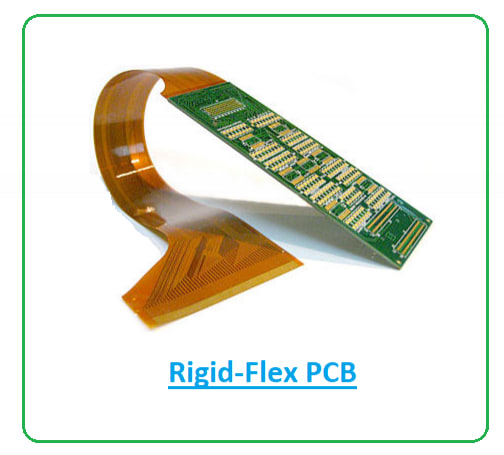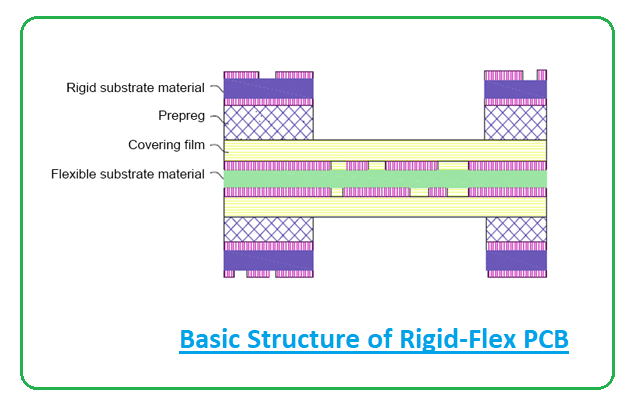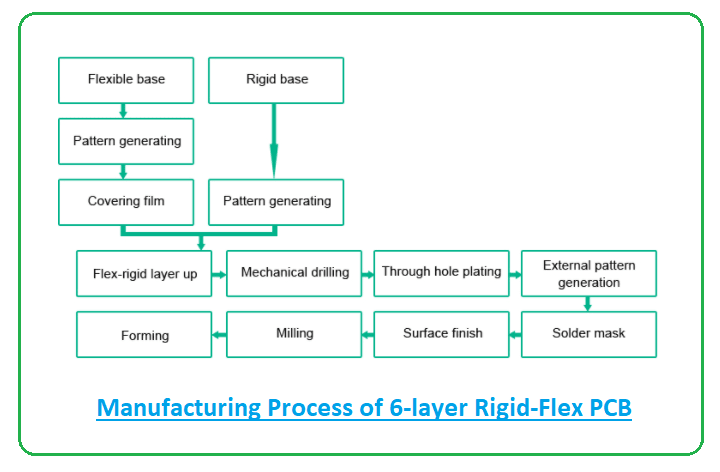Majority of electronic gadgets, PCBs are employed. Its tender bodily assistance and cabling sections for electronics features that are socketed or exterior.
Reinforced alternative metal matrix goods are normally employed for the production of PCBs. LEDs, mobile phones, cameras, radios, and TVs are examples of computerized and contemporary end-user devices that contain such.
You can locate them in layer configurations, and flexible, stiff, and rigid-flex chips. Although, this article would solely talk about Rigid-Flex Printed Circuit Board.
What is Rigid-Flex PCB?
Rigid-Flex PCBs were proposed as substitutes for rigid PCBs because it is a blend of an adjustable and stiff chip. It features the perks of rigid and flexible circuit chips.

The bulk of the rigid-flex chips are constructed out of numerous stacks of flexible chip supplies that are outwardly and internally linked to stiff chips. Flexible supplies are intended for the steady conditions of flex and are typically structured in a flexed chart or linear representation throughout the production or setup process. It is reliant on the model of the project.
Characteristics of Rigid PCB
- Rigid PCB is sort of the classic printed classic chip that is incapable of becoming distorted or rolled up into any arrangement thanks to the presence of the FR4 reinforcement, which is extremely beneficial for skyrocketing stiffness.
- A rigid PCB is produced from copper traces and lines infused on one particular chip to adhere the various features on it. The supply of the chip is a stiff ground substance that delivers stiffness and durability to the chip.
- This printed circuit chip featuring a stiff ground substance supply is ideally demonstrated by the circuit chip.
- It cannot get altered or rolled up into any other structure after they have been produced.
- It is extremely exorbitant in comparison to rigid PCB. They are classic PCBs that are capable of getting discovered in several different electronic goods.
- In regards to usability as well as access, both flexible and rigid PCBs possess their own major drawbacks and merits. You could decide to employ them both on your chip whenever you plan on linking several electrical parts.
How to Produce a Rigid-Flex PCB
In comparison to building normal chips, the construction of Rigid-Flex models is extremely difficult and intricate.
The construction procedure begins with the creation of a PCB layout using PCB modeling tools. The design softwares is simple to utilize, and anybody possessing even the slightest or without technical knowledge may get started producing the indispensable PCB models.
Rigid-Flex PCBs are constructed by heaping layers of rigid and flexible ground substance supply in an ordered fashion and linking them by utilizing plated THT.

The trustworthiness and robustness of the model eradicates the excessively thermal and friction problems that linkers and harnesses cause.
They were in existence longer than you could imagine, and their production method has evolved with time. Glass-fibre reinforced epoxy resin (FR4) is utilized as an outer stiff chip in the construction procedure, and a solder resist is employed on the rigid strata to resolve the rigid chip arrangement. The flexible substance is produced from a reinforced PA6-CF double-layer chip coated in copper, including an acrylic overlay utilized for safeguarding the flexible model arrangement.
The production procedures for the construction of rigid-flex chips are as follows:
- Getting the terminal supplies ready
- Producing the model for the chip
- Imprinting of the Cu overcoat
- Accurate machine burrowing
- THT overlay
- Utilizing a hood as a protectant for the boar technology
The construction procedure of a Rigid-Flex chip layout featuring a couple of stiff strata is depicted in the graphic. Contingent on flexible supply, the Rigid-Flex chip features great efficiency and is competent enough to get it flexed into any structure. The chip's flexible ground substance supply not merely enables flexibility, but also exhibits exceptional dielectric durability, making it ideal for resistance management and great pitch data transfer.

Flexible ground substance content features a significant humidity absorbency and a substantial heat expansion coefficient, allowing for size tolerance buildup, efficient chip patterning, drilling, layering, and plating.
Rigid-Flex PCB Examples & Applications
People usually employ this chip in diverse situations wherein the functionality of the chip ought to be attained without jeopardizing the structure's stiffness.
People usually employ them in corporate, industry, and warfare settings. They cater to all kinds of digital cameras, mobile devices, and smart gadgets. Thanks to their weight loss, room saving, and adaptable features, they are specifically notable in the healthcare company for producing cardiac pacemakers.
They are constructed for assisting sensitive and flimsy wire, reducing connectivity difficulties and increasing performance. In rigid-flex models, just a couple of the welding connections are mandated, consequently in an ideal connecting stability and turning them suitable for automotive and evaluating and assessing utilizations.
They are less costly to produce since they involve less transportation and setup charge. They are suitable for point-of-sale (POS) scanners and PC computing utilizations owing to their light mass and tiny size.
Merits of Rigid-Flex PCB
They combine the merits of rigid and flex chips. A couple of advantages they bring to customers and producers are as follows.

Mechanical Stability
They are constructed from many strata of flexible compounds that are linked to several rigid chips, giving out sturdiness and versatility to setup in difficult-to-grasp parts.
Agility
The chip gives excellent accuracy, consistency, and product packaging style freedom.
Connection Reliability
The hiked up equilibrium and polarity of the chip guarantees that they link to other electronic parts safely and securely.
Endure Harsh Surroundings
During the construction of electronic functions, bulky electronic parts are liable to stress and tremor. Whenever you are connecting electrical parts with rigid-flex structures, meanwhile, you would never have to bother with such concerns because the chips are constructed to endure extreme temperatures, thermal, radioactivity, trauma, and severe conditions.
Conclusion
The usage of natural supplies and rigid-flex PCB construction is a crucial source of the hiked prices for rigid-flexible PCB. Engineers are capable of finishing model development at a cheaper cost and bypass unnecessary expenses when they decide to team up alongside construction engineers at the onset of the project design process.







Top comments (0)
Some comments may only be visible to logged-in visitors. Sign in to view all comments.